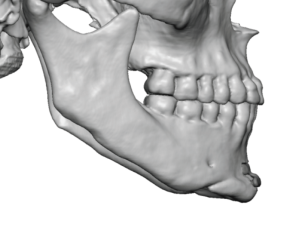The term ‘jaw reduction’ has evolved over the years to mean different types of procedures. Originally jaw reduction referred to an orthognathic surgery operation where the lower jaw was set back by an either a vertical oblique or sagittal split osteotomy to correct a malocclusion. It could also have referred to an aesthetic procedure of a reducing the front part of the jaw. (chin) More rarely it may have referred to a partial excision of the masseter muscle.
While jaws reduction may still refer to these long standing procedures its meaning has taken a different flavor being currently influenced by one of the more popular lower facial reshaping procedures in the world…V-line surgery. V-line surgery is the ultimate jaw reduction procedure as it reduces the size of the lower jaw from the jaw angles to the chin. While starting in Asian populations such as China and South Korea to reduce the ethnic tendencies for large jaw developments it is now widely applied to facial feminization efforts in non-Asians as well.

Regardless of who V-line surgery is done on the one well known adverse sequelae of jaw bone removal is loose skin.When you reduce bony support by stripping off soft tissue attachments there is going to be more lax skin. The only question is how significant will the issue be and will the patient want some form of a jowl tuck procedure.
As a result it is important to recognize that traditional V-line surgery is not for everyone. A modification of traditional V-line is what I call the Western version. Rather than reducing jaw size by changing its shape jaw width can be reduced by thinning the bone but leaving its vertical shape intact. While this can be done by generalized burring I prefer the corticotomy technique which creates more predictable bone removal and is also faster to perform.


Traditional V-line surgery is best utilized when the jaws angles are of medium to long lengths and/or when one wants to avoid any risk of soft tissue sagging.. But in high jaw angle patients width reduction is what is needed and the shape of the jaw angles should be preserved by outer cortical bone removal only.
Dr. Barry Eppley
World-Renowned Plastic Surgeon




